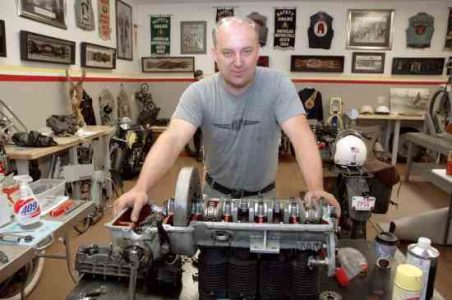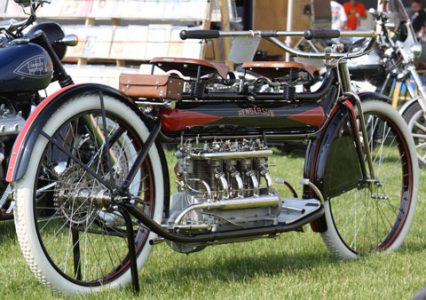2012 was the centenary of William Henderson’s eponymous motorcycle brand. Henderson, who designed his first 4-cylinder bike in Detroit, sold the company to Ignaz Schwinn, a bicycle manufacturer who moved production to Chicago and rebadged them Excelsior-Hendersons. They were the Honda Gold Wings of the day, but the Great Depression put an end to the marque in 1931. No less than 15 Hendersons were entered in this year’s Cannonball, but until a year ago, it would have been almost impossible to put so many on the road.
Enter Mark Hill, a motorcycle mechanics teacher at a small college in upstate New York. “I was just a kid when I bought my first Indian Four,” Mark says. “One ride on a bike like that and you’ll wonder how the public fell in love with V-twins!” When Frank Westfall rode an early Henderson Four in the first Cannonball, Hill followed him as a mechanic. The 2012 rules opened the field to more surviving bikes, but parts shortages prevented putting most of them on the road.
Underwritten by Cannonball entrants like Clyde Crouch and Byrne Bramwell (the latter a Canadian industrialist with excellent manufacturing connections) Hill coordinated the design of crankshafts, cylinders and cylinder heads, with connecting rods of 4143 steel and pistons forged from 2618 aluminum. They made camshafts and rocker assemblies. They spun-cast new babbitt bearings. They even cast new intake manifolds with a stylin’ “Cannonball Special” logo. Half of the Hendersons in the field had engines Hill had built with those components. “With the exception of the engine cases, these are new Henderson engines,” Hill says.
Hill might have sensed my skepticism, as I wondered if they should really be considered “old” bikes. “It’s not as if we were building a bunch of high-performance parts,” Hill says. “We only built what we had to build, to replenish the anemic supply.” That said, he also mentioned that Gary Rovison and Steve Alsteadt did the flow metrics on the new combustion chambers. I doubt Bill Henderson had a flow bench.
Five of Hill’s seven engines finished on perfect points, cementing his status as the current guru of the vintage American four. Success has its price. “This is not for the faint of heart or checkbook,” Hill says, guessing the average Henderson represented an $80,000 investment.
Read about the 2012 Cannonball in: Surviving the Motorcycle Cannonball Endurance Run.











